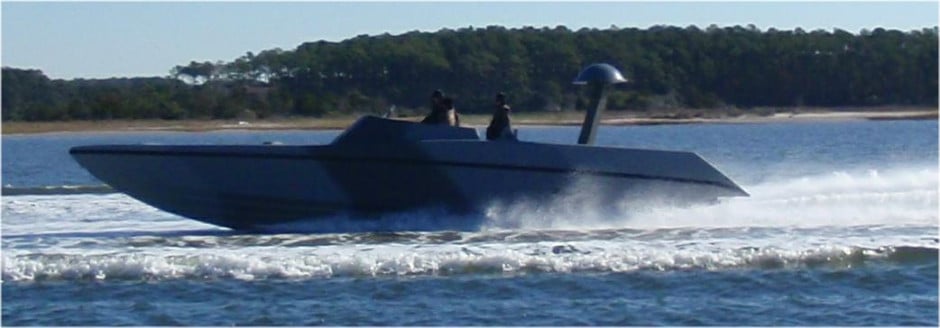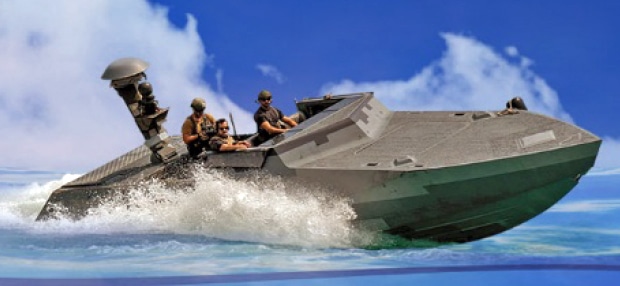The Combat Craft Assault is a cheaper version of the Combat Craft Medium (CCM). The CCA’s benefit is that it is light enough to be loaded into U.S. Air Force MC-130s and C-17s and Low-Velocity Airdropped into the sea, thus allowing U.S. naval special forces rapid insertion from anywhere in the world’s oceans.

Naval News reached out to USSOCOM and SOCOM declined any comment, only saying that all 32 CCA boats have been delivered. Nonetheless, through Open Source Intelligence (OSINT) obtained from public online UNCLASSIFIED military and industry web sources, Naval News can extrapolate and explain some of the key features of the USSOCOM Combat Craft Assault Insertion and Exfiltration speedboat.
What makes this DVIDS photo unique is the top-down perspective of the CCA, showing the CCA’s two-tone digital gray camouflage block pattern paintjob, and also the craft’s instrument panel and controls are visible since there is no roof. According to USMI, the “Deep Vee” 41-foot monohull SOCOM CCA is constructed of High-Tech composites (hence no rust streaks) and has a speed in excess of 40+ Knots. Range is unknown; however, a similar-sized boat, the 43-foot High Speed Interceptor Craft (HSIC) on USMI’s website has a range of 350 Nautical Miles.
The DVIDS photo shows the CCA’s engine is running as it is parked next to the USS Hershel “Woody” Williams Expeditionary Sea Base Four (ESB-4). The CCA’s engines power a Surface Drive System of Surface Piercing Propellers (SDS SPP). SPPs require a planning hull and according to the SDS industry, the SDS SPP has high reliability, endurance, speed, and the ability to enter shallow water. The Surface Piercing Propellers’ shapes and sizes can vary.

The non-digital uniform personnel with the Ops-Core ballistic helmets should be the U.S. Navy Sea Air Land (SEAL) Special Warfare Combatant-Craft Crewmen (SWCC) Teams since they are usually the ones to operate Combat Crafts that are unique and specific to USSOCOM.
The CCA’s fold-up/fold-down composite walls (1) are lowered to allow for boarding and off-boarding of the crew and also to prevent lateral movement of the passengers in addition to keeping away sea spray. They could be ballistically armored, although that is unconfirmed.
The CCA’s Boat Driver/Helmsman (center in blue jacket) has his right hand on the engine throttle, and to his left in camouflage is probably the Boat/Mission Commander, wearing a white face mask due to the COVID-19 pandemic. USNI lists some of the navigation features on the newer HSIC boat as: “Radar, GPS, Depth Finder, Magnetic Compass (4) Flux Gate Compass, Speed Log, Autopilot, and Wind Speed (features’ models dependent on Customer Requirements)” although the HSIC’s sensors don’t mean that the older 2010-designed model CCA has all of these navigational features.
Behind the SOCOM Naval Special Warfare (NSW) Boat/Mission Commander is a team of seven standing Visual Board Search and Seizure (VBSS) U.S. Navy SEALs (or Marines) behind him, all wearing Crye® MICH ballistic helmets with night vision goggle mounting brackets, black face masks, red life vests, and body armor. All seven appear unarmed with their weapons stowed.
According to the U.S. Navy, VBSS Teams consist of six sailors and two alternates in each team (one alternate shown here), and the photo seems to indicate this number. Typical VBSS Team armament would include a variety of carbines, handguns, shotguns, and possibly sniper rifles, lightweight to medium machine guns, and tube-launched grenade launchers for more serious threats.
Behind the seven VBSS Team stands one of the CCA’s boat crewmen, holding onto the radar mast (2). The radar mast is said to have been redesigned to accommodate the new Closed Circuit Forward Looking Infrared Version 2 (CCFLIR2) turret and the maritime search radar’s saucer-shaped dish on top. ). It is unclear what CCFLIR version the CCA has, but from the looks of the top-down photo, it appears to be the two-lens gyro-stabilized CCFLIR2 ball dated to 2015 (see photo) that has a Daytime color camera and an Infrared camera and a much smaller hole for a laser rangefinder/pointer (as evident by the yellow CAUTION radiation decals), and is painted black to be low-observable. Also unclear is if USSOCOM will redesign the CCA’s mast again to accommodate the flatter CCFLIR2 turret for the Combat Craft Medium (CCM) and Combat Craft Heavy (CCH) consisting of four instead of the two lenses.
The other U.S. Navy Combat Craft crewmember is climbing down the pilot ladder, and these two SWCCs will occupy the rear slot behind the VBSS team, giving the CCA four SWCC members aboard. They too can be armed in a similar fashion as the VBSS Team.






Low-Definition camera only shows the temperature ranges of the boat (e.g. Legacy FLIR) 
High-Definition thermal camera shows the edges, shapes, and details of the boat (SOCOM’s CCFLIR2 has HD) but without MSX Technology’s® visual merging, edge bordering and outlining

In my Naval News CCFLIR2 article, I stated that:
As to which FLIR technology the NAVSPECWARCOM boats have is unknown, but FLIR®Technologies confirmed over the phone that the MSX® Technology is hardware, not software related, and is not downloadable to cameras or systems that do not contain the MSX Technology. FLIR® Systems said that its handheld cameras do contain MSX Technology but could not confirm that the Maritime cameras contained MSX Technology. FLIR® Systems declined to comment on the CCFLIR2.
The CCA’s two Multi-function Display (MFD) terminals (B, 3) clearly show blue, green, red, and orange color outputs because “Forward Looking Infra-Red (FLIR) is essentially a thermal imager sensor that measures the ambient temperatures of objects and landscapes and creates a digital image video, enhanced with black, white, and a rainbow of colors for day/night navigation, target identification, heat source measurements, ranging, and tracking.”
The left terminal (B) seems to show this “rainbow of colors” in different wavelengths whereas the right terminal seems to show the Daytime color camera image to the left and to the right the four squares representing the “rainbow of colors” from the Infrared image. The CCFLIR2’s handheld controller is behind the Boat/Mission Commander and before the first row of the VBSS team (A). This monitor output is consistent with the two lens Fiscal Year 2015 CCFLIR2 model sold by FLIR® to USSOCOM.
The NSW’s CCA can possibly accommodate remote weapons and precision engagement missiles under the SOCOM Combat Craft Mission Equipment (CCME) program although such weapons, according to the virtual Special Operations Forces Industry Conference (SOFIC) 2020, are slated for the CCM and Combat Craft Heavy (CCH). Weapons can be placed in the forward hatch below the hull (such as the MK50 with .50cal heavy machine gun) or JQLs with JAGMs placed in the forward hatch or on the deck around the radar mast.





The post USSOCOM Combat Craft Assault Photo Reveals Some Key Featuresappeared first on Naval News.










No comments:
Post a Comment
How did you like the post, leave a comment. I would appreciate hearing from you all. Best wishes from JC's Naval, Maritime and Military News